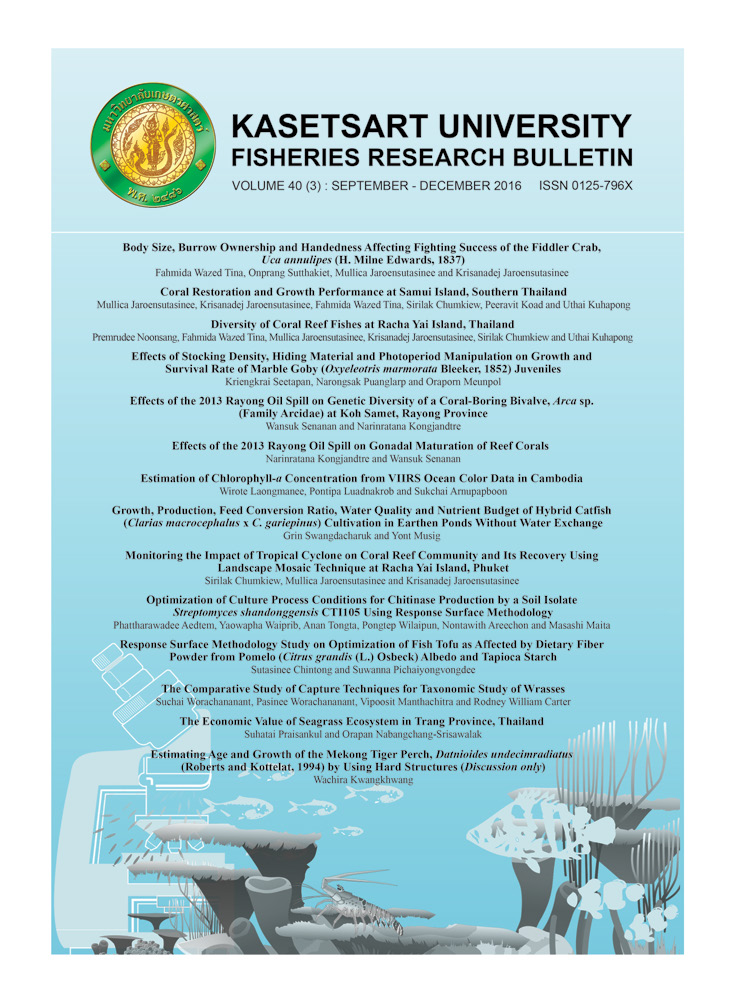The Comparative Study of Capture Techniques for Taxonomic Study of Wrasses
Main Article Content
Abstract
This study considers the variation of catch methods of wrasses for taxonomic study. Since most wrasses live in coral reefs, non-destructive methods are preferred. Four methods of a small spear gun, gill net, scoop net and baited hook were used to collect the fish samples. The gill net was the most successful capture method in terms of specimens and number of individuals caught, followed by the scoop net, baited hook and small spear gun. Given the diversity of sizes caught, the catch was divided into small (4-10 cm), medium (11-20 cm) and large (21-100 cm) sizes. The gill net proved to be the most successful capture method for all sizes, while the small spear gun and baited hook were successful only for medium and large fish, respectively. However, the scoop net was suitable for the capture of small and medium sized wrasses, although the quantity and diversity were less than the gill net. Wrasses are usually solitary or occur in pairs, but some form small schools, particularly in the juvenile phase. Accordingly, this study also divided the species caught into those that were solitary or in pairs, and schooling. Again, the gill net proved to be the most successful catch method, following by the scoop net, baited hook and small spear gun. The gill net is suitable equipment for both solitary and schooling wrasses, while the baited hook is effective only for solitary fish.
Article Details
References
2. Buckmeier DL, Schlechte JW (2009) Capture efficiency and size selectivity of channel catfish and blue catfish sampling gears. North. Am. J. Fish. Management 29: 404-416.
3. Carassou L, Mellin C, Ponton D (2009) Assessing the diversity and abundances of larvae and juveniles of coral reef fish: a synthesis of six sampling techniques. Biodiversity Conserv 18: 355-371.
4. Choat JH, Bellwood DR (1998) Wrasses and Parrotfishes. In: Encyclopedia of Animals: Fishes, 2nd edn (eds Paxton JR, Eschmeyer WN), Weldon Owen, San Diego, California, pp. 209-213.
5. Choat JH, Doherty PJ, Kerrigan BA, Leis JM (1993) A comparison of towed nets, purse seine, and light-aggregation devices for sampling larvae and pelagic juveniles of coral reef fishes. Fish Bull 91: 195-209.
6. Clarke KR, Gorley RN (2006) PRIMER v6: User manual/Tutorial.PRIMER-E, Plymouth, UK.
7. Costello MJ (1991) Review of the biology of wrasse (Labridae: Pisces) in Northern Europe. Prog. Underwat. Sci. 16: 29-51.
8. Cote IM, Perrow MR (2006) Fish. In: Ecological Census Techniques: A Handbook (ed Sutherland WJ), Ounbridge University Press, Cambridge, pp. 250-277.
9. Hickford MJH, Schiel DR (2008) Experimental gill-netting of reef fish: Speciesspecific responses modify capture probability across mesh sizes. J Exp Mar Biol Ecol 358: 163-169.
10. Hixon MA, Beets JP (1993) Predation, prey refuges, and the structure of coral reef fish assemblages. Ecol Monogr 63: 77-101.
11. Lunneryd SG, Westerberg H, Wahlberg M (2002) Detection of leader net by whitefish Coregonus lavaretus during varing environmental conditions. Fish Res 54: 355-362.
12. Michael AW, Laura W (1994) Thropical reef fishes: A marine awareness guide on fishes from the Indo-Pacific realm, Great Barrier Reef, Australia, Indonesia Archipelago, Bunaken Marine Park, North Sulawesi, Maldives, Malaysia, Philippines, Thailand, South Pacific Islands, Ocean grographic media, Malaysia. 126 pp.
13. Murphy HM, Jenkins GP (2010) Observational methods used in marine spatial monitoring of fishes and associated habitats: a review. Mar Freshw Res 61: 236-252.
14. Nelson JS (1994) Fishes of the world. 3rd edn, John Wiley & Sons, Inc., New York. 600 pp.
15. Randall JE, Allen GR, Steen RC (1990) Fishes of the Great Barrier Reef and Coral Sea, University of Hawaii Press, Honolulu. 557 pp.
16. Reopanichkul P, Carter RW, Worachananant S, Crossland CJ (2010) Wastewater discharge degrades coastal waters and reef communities. Mar Environ Res 69: 287-296.
17. Reopanichkul P, Schlacher TA, Carter RW, Worachananant S (2009) Sewage impacts coral reefs at multiple levels of ecological organization. Mar Pollut Bull 58: 1356-1362.
18. RFD (2002) Handbook of marine national park tourism: Andaman Sea. Marine National Park Division, The Royal Forest Department (RFD), Bangkok, Thailand. (Published in Thai)
19. Thorrold SR (1992) Evaluating The performance of light traps for sampling small Wsh and squid in open waters of the Central Great Barrier Reef lagoon. Mar Ecol Prog Ser 89: 277-285.
20. Treasurer JW (1996) Capture techniques for wrasse in inshore waters of west Scotland. In: Biology and use in aquaculture (eds Sayer MDJ, Treasurer JW, Costello MJ), Blackwell Berlin, pp. 74-90.
21. Treasurer JW (2000) Evaluation of the relative catching power of pots for north European wrasse (Labridae). J Appl Ichthyol 16: 36-38.
22. Tuya F, Wemberg T, Thomsen MS (2009) Habitat structure affect abundances of labrid fishes across temperate reefs in south-western Australia. Environ Biol Fishes 86: 311-319.
23. Underwood AJ (1981) Techniques of analysis of variance in experimental marine biology and ecology. Oceanogr Mar Biol Annu Rev 19: 513-605.
24. Wainwright PC, Bellwood DR (2002) Ecomorphology of feeding in coral reef fishes. In: Coral Reef Fishes. Dynamics and diversity in a complex ecosystem (ed Sale PF), Academic Press, San Diego, pp.33-56.
25. Willis TR, Anderson MJ (2003) Structure of cryptic reef fish assemblages: relationships with habitat characteristics and predator densit. Mar Ecol Prog Ser 257: 209-221.

